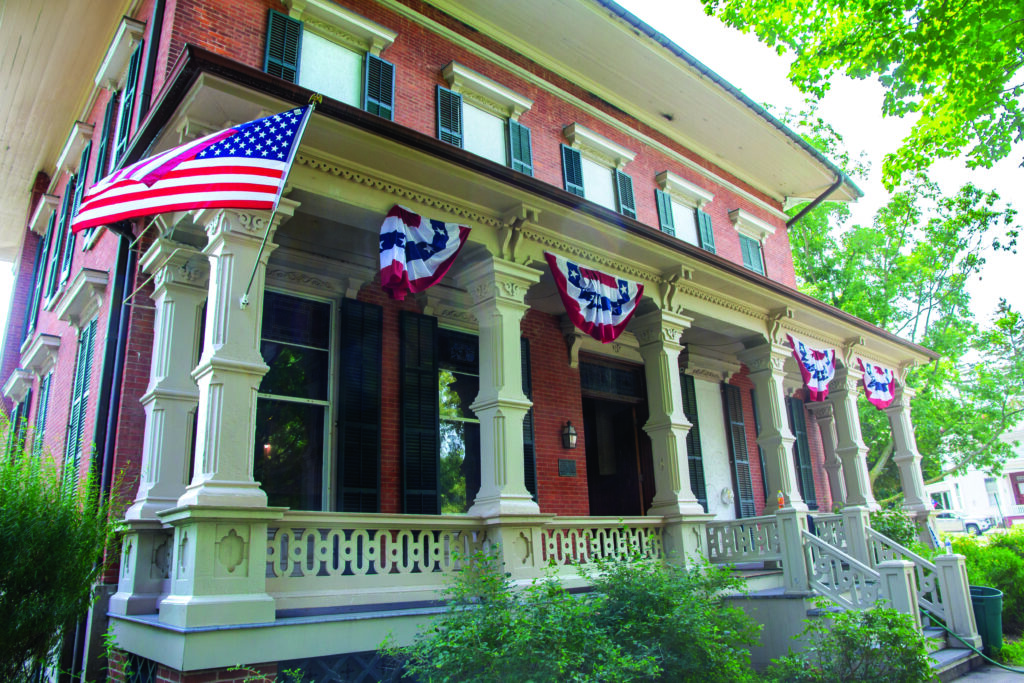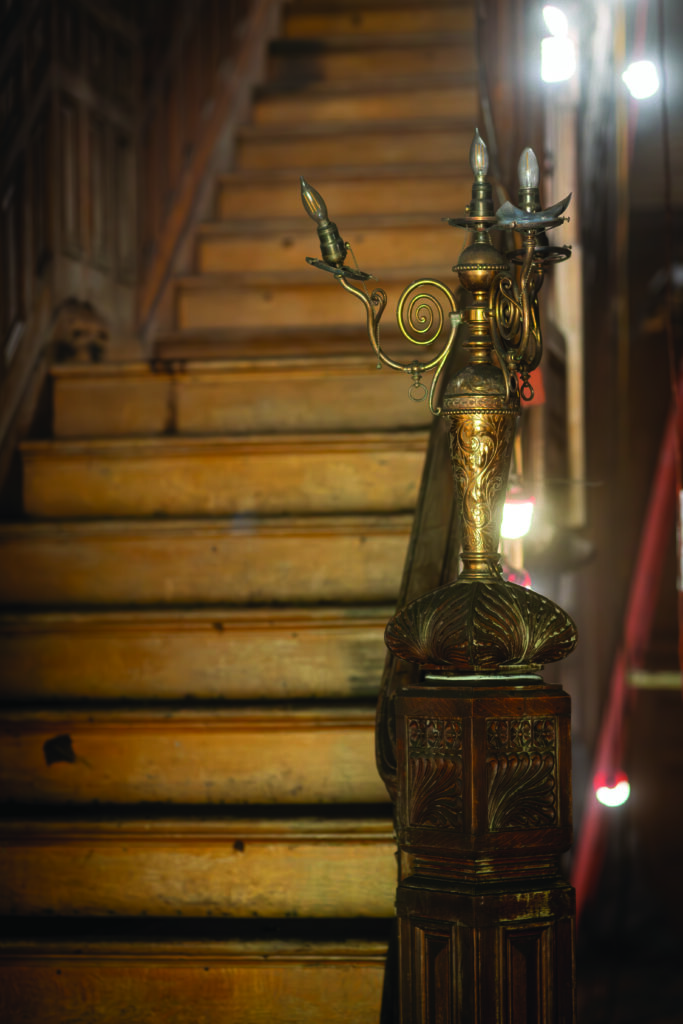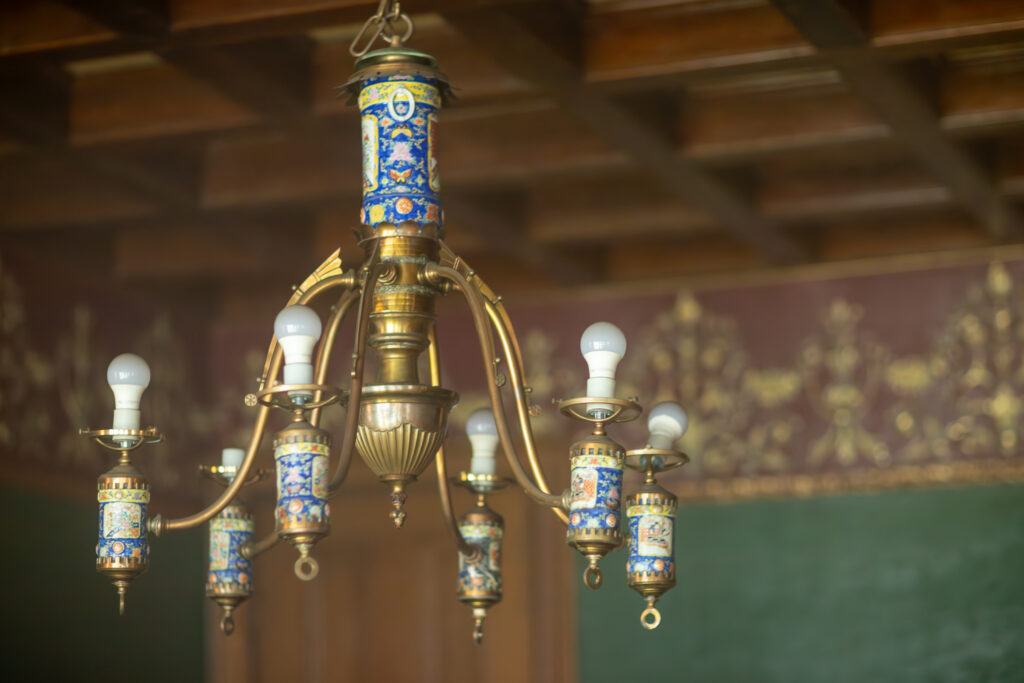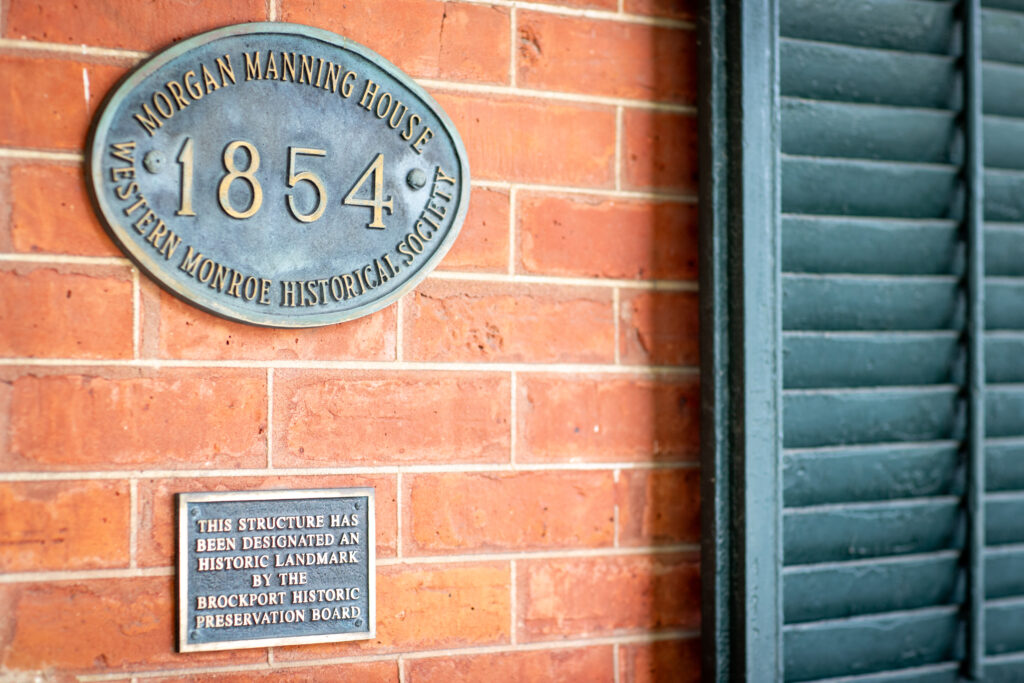
The Morgan-Manning House is an iconic fixture situated on the picturesque Main Street of Brockport. Now a museum, the two-story brick Victorian-era home is listed on the National Register of Historic Places and is a designated Point of Interest on the Erie Canalway National Heritage Corridor. The Italianate-style residence, complete with a full porch, low-hipped roof, and cupola, features portraits of locally prominent nineteenth-century residents, period furnishings, and archival materials related to the Morgan family.
Built in 1854 by John Ostrom, the Morgan Homestead was sold to Dayton Morgan, a local industrialist in 1867. Morgan manufactured the first mechanized reapers for Cyrus McCormick, revolutionizing the way that hay could be cut and gathered. Over the years, the family remodeled the main floor in the late Victorian style and added a carriage house in the back. The home stayed in the family until 1964, when a fire damaged the building. Sara Morgan Manning, who was living in the home, died shortly after the fire due to smoke inhalation.
The home was bequeathed to the community, and a group of local citizens formed the Western Monroe Historical Society, a nonprofit committed to the fulfillment of Sara Morgan Manning’s wish that her home would “stand forever as a monument to the fine old traditions that are so important to our heritage.”
Bringing the community together with annual celebrations and community events like the Outdoor Summer Pops Concert and the Old Fashioned Fourth of July, the Morgan-Manning House has also hosted Shakespeare on the Lawn and A Candlelight Christmas as well as presentations by authors and historians.
Visitors over the years have enjoyed touring the home, from the grand staircase to the ornate furnishings and piano. The master bedroom showcased the fashion of the time period with a collection of women’s attire on dress forms. A children’s room displayed antique toys, books, and dolls. The home stood fully restored and furnished for sixty years until tragedy struck once again.
On January 14 of this year, Paul Kimball arrived at the Manning House with the rest of the board members just before seven o’clock in the evening for their monthly meeting. They opened the side door and were confronted with smoke escaping from the home.





Sparked by a faulty component in the basement boiler, the small fire spread quickly, making its way up to the attic and collapsing the second floor. Had the members not met that night, Kimball is certain that the landmark would have been completely destroyed.
“I was actually board president the night of the fire.” He recalls watching the devastating scene from across the street as fire fighters battled the flames on that frigid winter evening for over five hours. When the smoke cleared, a team began to assess the extensive water and fire damage.
Kimball jokes that he lost his job two days after the fire, but the truth is that he immediately resigned as president to focus full-time on managing the restoration project. Having served as town supervisor of Clarkson for thirty-four years, he knew that stepping into the role of project manager would be a full-time job.
A lifelong resident of Brockport, Kimball remembers the first fire at the Manning House. He was twelve years old and delivering newspapers. Ironically, one of his customers that day was Morgan Manning’s sister-in-law, who lived at the other end of the village.
Renovation efforts after the fire of 1965 consisted of mostly volunteers as the fire was fairly limited. But this time around, the damage was devastating. The asbestos and debris removal have cost a small fortune alone, and the cost to restore the entire house has been estimated at three million dollars.
I visited the Manning House on a humid day in July. Men in protective suits and masks were sandblasting, working hard to salvage the original wood. The team from Struck and Sons specializes in fire restoration and historic homes. There was a chimney sitting in the living room. A charred bed frame leaned against a wall in the summer kitchen, one of the only rooms untouched by the fire.



The reception room and the library were the only other rooms that did not have to be completely gutted. These two spaces showcase the most elaborate interior woodwork, period plasterwork, and stained glass in the home. None of the stained glass was damaged, including one unique piece made from a combination of two windows that were broken in the first fire. Thankfully, a majority of the historic artifacts were saved, including a portrait of Hiel Brockway, founder of Brockport, which was found sitting in the hallway unscathed, surrounded by charred debris.
I saw black watermarks lining the lower area of the walls, evidence of the great amount of water that flowed through the rooms to fight the fire. Kimball pointed out a chandelier in the dining room which was dripping with icicles the day after the fire and a hole in the decorated ceiling. He described how the chimney fell through, followed by the pool table from the billiards room. Kimball opened his palm to reveal several hand-cut nails, all that’s left of one of the burned planks of wood. “These are blacksmith-cut nails. That’s what the house was put together with in 1854.”
In addition to the extensive damage to the interior, the devastation is apparent on the exterior as well. A portion of the four-sided hipped roof flipped over during the fire and came crashing down, breaking off pieces of the decorative parts of the windows as it fell. One of the two chimneys landed on the ground outside, and the other crashed through to the bottom of the house.
The vision ahead is clear: complete restoration for the beloved landmark and the community of Brockport. The board is committed to rebuilding, and Kimball says the goal is to make everything look like it did on January 13. The roof is projected to be finished by October, and then the work can begin on the interior. The whole project may be able to be completed in as little as two years. Visit the Morgan-Manning website to become a member or learn more about upcoming fundraisers and events.
Donations are gratefully accepted at morganmanninghouse.org.
This article originally appeared in the September/October 2025 issue of (585).
Views: 51




